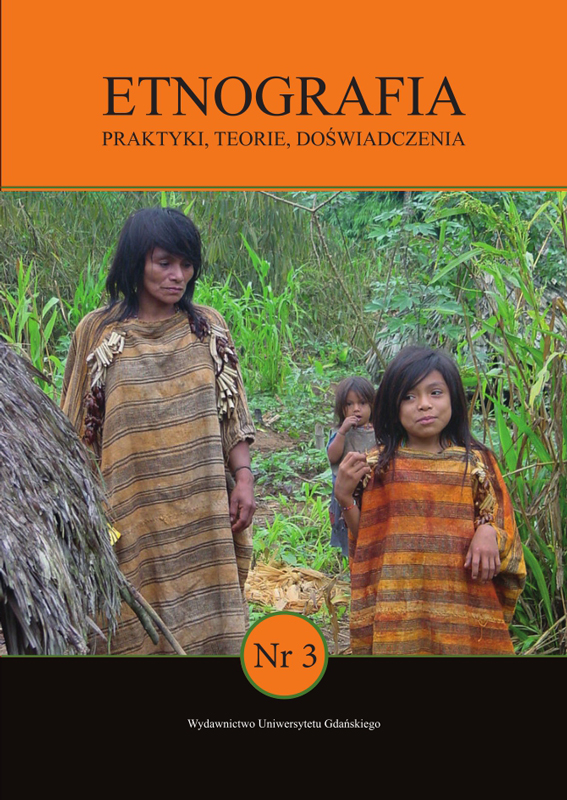Niespecyficzne duchy, przewrotne opowieści – budowanie wyobrażeń na temat osób nie-ludzkich w narracjach ludu Arabela (Amazonia peruwiańska)
DOI:
https://doi.org/10.4467/254395379EPT.17.004.9240Słowa kluczowe:
Amazonia, animism, perspectivism, anthropology of nature, acquisition and transmission of representationsAbstrakt
This article is an attempt to extend the pragmatic reflection on ritual language as a means of transmission of animic representations from ritual contexts to the context of everyday narratives. It contains an analysis of a couple of first-person Arabela narratives about being abducted by sweet water dauphin. The article shows that language and structure of those narratives are characterized by counterintuitive mode of relation between the speaker and the events represented in the tale, build on different levels of language and narrative structure. It is obtained mostly by two features: unspecificity and lacunarity. The former characterizes the terms relating to non-human persons a nd shamans – extraordinary experiences are referenced to by means of terms relating to the shared experience of all Arabela. The latter relates to the fact that many aspects of non-human existence and human/non-human interaction are eluded in the story, even when the speaker is explicitly questioned about them.
Downloads
Bibliografia
Baer, G. (1979). Religión y Chamanismo de los Matsigenka (Este peruano). Przeł. Van Ronzelen-Huapaya. Amazonía peruana, 2(4), 101–138.
Boyer, P. (1994). The naturalness of religious ideas: a cognitive theory of religion, Berkeley–Los Angeles–Londyn: University of California Press.
Cesarino, P. de N. (2008). Oniska: A poética da morte e do mundo entre os Marubo da Amazônia ocidental, praca doktorska. Brazylia: PPGAS-MN/UFRJ.
Chaumeil, J.-P. (1993). Del proyectil al virus. El complejo de dardos-mágicos en el chamanismo del oeste amazónico. W: C. Pinzon, R. Suarez, G. Garay (eds.), Cultura y salud en la construcción de las Américas. Przeł. G. Garay. Bogota: Instituto Colombiano de Cultura.
Chaumeil, J.-P. (2002). Ciudades encantadas y mapas submarinos. Redes transnacionales y chamanismo de la frontera en el Trapecio amazónico. W: F. Morin, R. Santana (eds.), Lo Transnacional, Instrumento y desafío para los pueblos indígenas. Quito: Ediciones Abya-Yala.
Costa, L., Fausto, C. (2010). The Return of the Animists. Recent Studies of Amazonian Ontologies. Religion and Society: Advances in Research, 1, 89–109.
Czeremski, M. (2014). Bohaterowie optymalnie niemożliwi. Geneza, struktura i funkcje mitycznej kontr intuicyjności. Rocznik Lubuski, 42 (2), 29–49.
Déléage, P. (2009). Le chant de l’anaconda. L’apprentissage du chamanisme chez les Sharanahua (Amazonie occidentale). Nanterre: Société d’Ethnologie.
Descola, P. (2005). Par-delà nature et culture. Paris: Gallimard.
Fausto, C. (2007 [1999]). O wrogach i oswojonych zwierzętach: wojna i szamanizm w Amazonii. Przeł. Ł. Krokoszyński. W: M. Kairski, T. Buliński (red.), Sny, geny, trofea i zmarli. „Wojna” w społeczeństwach przedpaństwowych na przykładzie Amazonii – przegląd koncepcji antropologicznych (s. 353–402). Poznań: Wydawnictwo Naukowe UAM.
Gutierrez Choquevilca, A.-L. (2011). Sisyawaytii tarawaytii: sifflements serpentins et autres voix d’esprits dans le chamanisme quechua du haut Pastaza (Amazonie péruvienne), Journal de la société des américanistes, 97(1), www.journals.openedition.org/jsa/11724 [dostęp: 6.01.2017].
Gutierrez Choquevilca, A.-L. (2012). Voix de „maîtres” et chants d’oiseaux: pour une étude pragmatique de l’univers sonore et la communication rituelle parmi les Quechua d’Amazonie péruvienne, praca doktorska. Paris: Uniwersytet Paris 10 Nanterre.
Levinson, S.C. (1988). Pragmatics. Cambridge: Cambridge University Press.
Rogalski, F. (2015). Animizm, perspektywizm i sprawczość u ludu Arabela z Amazonii peruwiańskiej, praca doktorska. Poznań: Uniwersytet im. Adama Mickiewicza.
Severi, C. (2004). Capturing imagination: a cognitive approach to cultural complexity. Journal of the Royal Anthropological Institute (N.S.), 10, 815–838.
Severi, C. (2008). El Yo-memoria. Una nueva aproximación a los cantos chamánicos amerindios. Cuicuilco, 15(42), 11–28, www.redalyc.org/articulo.oa?id=35112172002 [dostęp: 7.03.2016].
Viveiros de Castro, E. (1998). Cosmological Deixis and Amerindian Perspectivism. The Journal of the Royal Anthropological Institute, 4(3), 469–488.
Willerslev, R. (2004). Spirits as „ready to hand”: A phenomenological analysis of Yukaghir spiritual knowledge and dreaming. Anthropological Theory, 4(4), 395–418.
Pobrania
Opublikowane
Jak cytować
Numer
Dział
Licencja
Czasopismo wydawane jest na licencji Creative Commons Uznanie autorstwa-Na tych samych warunkach 4.0 Międzynarodowe.

 Uniwersyteckie Czasopisma Naukowe
Uniwersyteckie Czasopisma Naukowe








